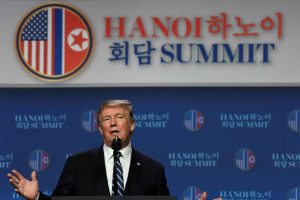MARCH 2, 2019

WASHINGTON, D.C. — Assailed by his ex-lawyer at every turn, President Donald Trump nevertheless claimed a measure of vindication from Michael Cohen’s statement that he possessed no direct evidence of collusion with Russia from his time serving the boss. But contrary to Trump’s words, Cohen did not exonerate him on the matter in his testimony to lawmakers.
Trump also put the best face on his summit with North Korean leader Kim Jong Un, claiming he had a “really productive time” in Hanoi, Vietnam, despite the collapse of talks and cancellation of a planned signing agreement. More substantively, he claimed the talks broke down because North Korea insisted on the lifting of all sanctions — an assertion contradicted by the State Department as well as by the North Koreans.
On other recent rhetorical fronts, the president credited his daughter with creating jobs that don’t exist and Democrats persisted in their distorted accusation that the Trump administration confined migrant children in cages.
A review:
COHEN TESTIMONY
TRUMP: “He said no collusion. And I was, you know, a little impressed by that, frankly. Could’ve — he could’ve gone all out. He only went about 95 percent instead of 100 percent.” — Hanoi news conference Thursday.
THE FACTS: He takes Cohen’s comment too far. Cohen did not clear his former boss on the question of whether his campaign colluded with Russia to influence the 2016 election. In the course of implicating Trump in other alleged criminal activity, Cohen said he did not witness or know directly of collusion “but I have my suspicions.” He didn’t say “no collusion.”
Cohen told lawmakers: “So, as I stated in my testimony, I wouldn’t use the word ‘colluding.’ Was there something odd about the back-and-forth praise with President Putin? Yes, but I’m not really sure that I can answer that question in terms of collusion. I was not part of the campaign. I don’t know the other conversations that Mr. Trump had with other individuals. There is just so many dots that all seem to lead to the same direction.”
And: “The questions have been raised about whether I know of direct evidence that Mr. Trump or his campaign colluded with Russia. I do not, and I want to be clear. But I have my suspicions.”
___
REP. JIM JORDAN, top Republican on the House Oversight and Reform Committee: “Remember how all this started. The Clinton campaign hired Perkins Coie law firm who hired Glenn Simpson who hired a foreigner, Christopher Steele, who put together the fake dossier that the FBI used to go get a warrant to spy on the Trump campaign.” — remarks Wednesday at the hearing with Cohen.
THE FACTS: He’s repeating a false claim by Trump that special counsel Robert Mueller’s Russia probe is based on a “fake dossier.” The FBI’s investigation actually began months before it received a dossier of anti-Trump research financed by the Democratic Party and Hillary Clinton’s campaign. The FBI probe’s origins were based on other evidence — not the existence of the dossier, which has not been discredited.
Last year, the Republican-controlled House Intelligence Committee found the Russia probe was initiated after the FBI received information related to Trump campaign foreign policy adviser George Papadopoulos, not the dossier. The committee’s final report was praised by Trump.
___
NORTH KOREA
TRUMP, on his summit: “We had a really, I think, a very productive time.” — Post-summit Hanoi news conference
THE FACTS: The talks fell apart, lunch was canceled, a signing ceremony scrapped and Trump said another meeting with Kim “may not be for a long time” before he left to come home two hours early. Moreover, they came away disagreeing about what they had disagreed about.
___
TRUMP: “Basically, they wanted the sanctions lifted in their entirety, and we couldn’t do that.” — Hanoi news conference.
THE FACTS: A senior State Department official said North Korea demanded Trump’s support for the lifting of U.N. Security Council sanctions imposed since March 2016 — not other sanctions. The official spoke on condition of anonymity because he was not authorized to publicly discuss the private negotiations.
Although North Korea wants all sanctions erased, the official said, Kim was pressing for relief from ones that impede the civilian economy and was not demanding an end to sanctions on armaments. Altogether, Kim was seeking substantial relief, insisting bans be lifted on trade in goods and commodities such as metals, raw materials, luxury items, seafood, coal exports, refined petroleum imports and raw petroleum imports. But he did not insist that sanctions be “lifted in their entirety,” as Trump asserted.
___
MIGRANT CHILDREN
REP. ELIJAH CUMMINGS, Democratic chairman of House Oversight and Reform Committee, on Trump: “I want him when he goes out there and he does things, I want him to think about children. I want him to think about the children that he separated from their parents. I want him to think about the fact that we had children in cages.” — remarks Wednesday to reporters.
THE FACTS: He’s echoing a Democratic talking point that seizes on a visceral image of kids in “cages” as evidence of Trump administration cruelty. But the claim lacks context. The “cages” are actually chain-link fences and the Obama administration used them for migrant children, too.
Children are held behind the fences inside Border Patrol facilities. Obama’s administration detained large numbers of unaccompanied children in such a manner in 2014 during a surge of migrant children at the border. Images that circulated online of children in chain link pens during the height of Trump’s family separations controversy — and blamed on him — were actually from 2014 when Obama was in office.
Children are placed in such areas by age and sex for safety reasons and are generally held for up to 72 hours by the Border Patrol. They then go into the custody of the Health and Human Services Department and are housed in shelters until they are placed with sponsors in the U.S., usually parents or close relatives. Some children who are with their families will go into family detention or will be released with their family into the country as their immigration cases play out.
The Homeland Security Department’s inspector general visited five detention facilities for unaccompanied children on the Texas border with Mexico in late June, during the height of the furor over family separations, and found the facilities appeared to comply with detention standards. The government watchdog reported that cleanliness was inconsistent but that the children had access to toilets, food, drinks, clean bedding and hygiene items.
At the height of the family separations, about 2,400 children were separated. Since then, 118 children have been. Immigration officials are allowed to take a child from a parent in certain cases — serious criminal charges against a parent, concerns over the health and welfare of a child or medical concerns.
That policy has long been in place and is separate from the now-suspended zero-tolerance Trump administration policy that saw children separated from parents only because they had crossed illegally.
___
BORDER-DRUGS
“Ninety percent of the drugs don’t come through the port of entry. Ninety percent of the drugs and the big stuff goes out to the desert, makes a left, and goes where you don’t have any wall.” — Trump’s remarks to governors Monday.
THE FACTS: Not true, according to federal findings that Trump repeatedly ignores. The majority of drugs crossing the southern border comes in at land ports of entry, not territory between them.
The Drug Enforcement Administration, Customs and Border Protection and other agencies rely on vast surveillance capabilities, intelligence from informants and other sources, seizure data and other evidence to reach that conclusion.
On seizures alone, fully 90 percent of heroin crossing U.S. borders was intercepted at entry ports, not territory between them, and similar percentages of other drugs — methamphetamines, cocaine and fentanyl — were also seized at these checkpoints, U.S. officials say. Marijuana is an exception, primarily smuggled between entry ports.
Trump justifies his declaration of an emergency at the border in part by citing a need to stop drug shipments, most of which in fact would not be impeded by any wall. In Trump’s telling, vehicles full of drugs invariably make a left after crossing some remote stretch of the border.
Customs and Border Protection deploys about 23,000 personnel at airports, land crossings and seaports and close to 20,000 between entry ports.
___
IVANKA TRUMP
TRUMP: “My daughter has created millions of jobs. I don’t know if anyone knows that, but she’s created millions of jobs. … Last year, my administration created the Council for American Worker and launched the Pledge of America’s Workers, where we’ve gained commitments from private sector leaders to hire and train more than 6.5 million Americans. Think of it: 6.5 million. And these are jobs that, for the most part, would not have happened.” — remarks to governors Monday.
THE FACTS: Actually, Trump’s daughter Ivanka, a White House adviser, did not create “millions” of jobs. Nor did the White House Council for the American Worker, which she helps lead, create 6.5 million jobs as Trump suggests.
Trump established the council by executive order in July. It is aimed in part at getting companies to sign onto a pledge to give students and workers more job training and skills development opportunities in the face of impending automation. Two hundred companies have since agreed to the pledge, offering training opportunities that total more than 6.5 million, according to the White House.
But the training opportunities are neither actual job openings nor are they being immediately provided. The White House describes the programs as opportunities “over the next five years,” including “apprenticeships and work-based learning, continuing education, on-the-job training, and reskilling.”
___
FENTANYL DANGERS
TRUMP, on the dangers of fentanyl: “A little tiny spoonful can wipe out a state. It’s hard to believe. It can wipe out an entire state, a spoonful of this stuff.” — remarks to governors Monday.
THE FACTS: It can’t.
Fentanyl can be extraordinarily lethal as well as addictive.
The Drug Enforcement Administration cited evidence in a case last year that 1 gram of fentanyl can kill 300 people to 500 people. The case involved a Belleville, Illinois, man convicted in Texas of trafficking nearly 12 kilograms (26 pounds) of the drug, which the agency says is enough to kill up to 5.8 million people.
A teaspoon generally holds 4 grams to 6 grams, depending on the dry substance, equating to a theoretical death toll from fentanyl of 1,200 to 3,000, far from Trump’s claim that an amount that small can wipe out “an entire state.” That’s because the state with the smallest population, Wyoming, has about 578,000 people. It would take close to 200 teaspoons to kill a population of that size.
___
NATO
TRUMP: “We’ve picked up over a $100 billion just in NATO over the last two years. A hundred billion dollars more has come in.” — Hanoi news conference.
THE FACTS: His numbers are off, and the notion that more money has “come in” is misleading.
The NATO secretary-general, Jens Stoltenberg, said on Feb. 15 that NATO allies in Europe and Canada had spent an additional $41 billion on their own defense since 2016, and that by the end of 2020 that figure would rise to $100 billion. So, the $100 billion refers to additional military spending over a four-year period, not over the past two years.
Trump typically frames the issue as one of money being paid to the U.S. or to NATO itself. In reality, it’s a matter of how much each country in the alliance spends on its own military capabilities. Their increased spending is meant to lessen dependence on the U.S. for the defense of member countries.
In 2014, during the Obama administration, NATO members agreed to move “toward” spending 2 percent of their gross domestic product on their own defense by 2024. Trump’s pressure may have spurred some countries to increase their spending faster than they planned or to become more serious about moving to the 2 percent goal.
___
HARRY REID
TRUMP: “Former Senator Harry Reid (he got thrown out) is working hard to put a good spin on his failed career.” — tweet Monday.
THE FACTS: Reid wasn’t “thrown out” of office — by voters, fellow Democrats or anyone. He retired.
The longtime Senate Democratic leader announced in March 2015 that he would not seek another term and would retire after five terms, citing in part health concerns after falling while exercising and suffering serious bruises and a lasting injury to his right eye.
Reid, who was 75 at the time, said he would serve out the rest of his term in the Senate, which he in fact did, retiring in January 2017. Now he’s been dealing with pancreatic cancer.
___
VOTER FRAUD
SENATE MAJORITY LEADER MITCH McCONNELL: “Now, for years and years, every Republican who dared to call for commonsense safeguards for Americans’ ballots was demonized by Democrats and their allies. We were hit with left-wing talking points insisting that voter fraud wasn’t real. That fraud just didn’t happen. That modest efforts to ensure that voters are who they say they are and are voting in the proper place were really some sinister right-wing plot. As you might expect, now that an incident of very real voter fraud has become national news and the Republican candidate seems to have benefited, these long-standing Democrat talking points have quieted. … I’ve been focused for decades on protecting the integrity of our elections.” — remarks in the Senate on Tuesday.
THE FACTS: McConnell suggested the election debacle in North Carolina could have been prevented by Republican efforts, including his own, to fight “voter fraud” with voter ID laws, and he blamed Democrats for inaction on the issue. But the Republican drive to require people to show identification when they show up to vote is not on point to what happened in North Carolina.
The case of malfeasance involving Republican Mark Harris’ congressional campaign in November focused on absentee mail-in ballot fraud, not voter impersonation at the ballot box. Voter IDs are powerless to stop mail-in ballot fraud.
The North Carolina State Board of Elections last month ordered a new election in the district, citing the voting improprieties. According to testimony during a state elections board hearing, Harris hired political operative Leslie McCrae Dowless Jr., who collected absentee ballots from voters by offering to put them in the mail. Some of Dowless’ associates testified they collected blank or incomplete ballots, then forged signatures and filled in votes for local candidates. Dowless was arrested Wednesday on criminal charges over his collection of absentee ballots.
McConnell is correct that Republicans and Democrats in Congress have debated election security for years. The Republican efforts in Congress have centered on voter ID laws, including an amendment McConnell offered in 2007 to require ID to help prevent non-citizens from voting at the ballot box. Democrats have opposed voter-ID laws as unnecessarily restrictive for nonwhites, the poor and young people, who tend to vote Democratic.
The actual number of election fraud cases is very small, and the type that voter IDs is designed to prevent — voter impersonation at the ballot box — is virtually nonexistent.
A 2012 report by News21, a reporting project affiliated with Arizona State University, found 2,068 cases of election fraud in the United States since 2000. Ten of those cases involved voter impersonation, or 1 out of every 15 million prospective voters. Mail-in absentee fraud was more common, with 491 cases. None of those instances affected the outcome of an election.
Courtesy/Source: AP









































































































